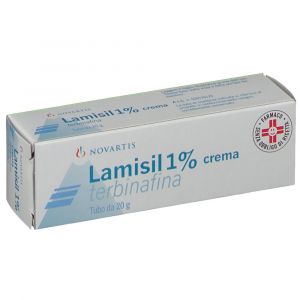NAME
LAMISIL 1% CREAM
PHARMACOTHERAPEUTIC CATEGORY
Topical antifungals.
ACTIVE PRINCIPLES
Terbinafine base.
EXCIPIENTS
Sodium hydroxide, benzyl alcohol, sorbitan monostearate, cetyl palmitate, cetyl alcohol, stearyl alcohol, polysorbate 60, isopropyl myristate, demineralized water.
INDICATIONS
Fungal infections of the skin and its appendages, caused by dermatophytes, or by Trichophyton (eg T. rubrum, T. mentagrophytes, T. verrucosum, T. violaceum), Microsporum canis and Epidermophyton floccosum. from the genus Candida (eg C. albicans). Pityriasis (tinea) versicolor caused by Pityrosporum orbiculare (also known as Malassezia furfur).
CONTRAINDICATIONS / SECONDARY EFFECT
Hypersensitivity 'to terbinafine or to any of the excipients; generally contraindicated in pregnancy and lactation; do not administer to children younger 'less than 12 years.
DOSAGE
For cutaneous use. Adults and children from 12 years onwards: the medicine can be applied once or twice a day, depending on the indication. >> Frequency and duration of treatment. Tinea corporis, cruris: once a day for 1 week. Tinea pedis (interdigital type): once a day for 1 week. Skin candidiasis: once or twice a day for 1 week. Pityriasis versicolor: once or twice a day for 2 weeks. The reduction of clinical symptoms is normally observed already after a few days. Irregular use or premature discontinuation of treatment may involve the risk of relapse. In particularly serious cases, therapy can be continued in the opinion of the doctor. If there is no improvement after two weeks of treatment, a check of the diagnosis is recommended. Pediatric population: as there is limited clinical experience in the use of the product in children younger than 12 years, it is not recommended for use in this age group. Elderly patients: no clinical data have emerged recommending a different dosage of Lamisil cream in elderly patients, nor are there any reports of side effects different from those found in young patients. Method of administration: carefully clean and dry the infected areas before proceeding with the application. The cream should be applied to the infected area and the nearby area in a thin layer, rubbing gently. In the case of intertriginous infections (submammary, interdigital, intergluteal, inguinal) the treated area can be protected with a gauze, particularly during the night.
STORAGE
This medicinal product does not require any special storage conditions.
WARNINGS
The medicine is for external use only. It can be irritating to the eyes. In case of accidental contact with the eyes, rinse thoroughly with running water. Do not administer to children younger 'less than 12 years. The product contains cetyl alcohol and stearyl alcohol which can cause local skin reactions (eg contact dermatitis).
INTERACTIONS
There are no known drug interactions with topical forms of terbinafine.
SIDE EFFECTS
Symptoms such as itching, peeling of the skin, pain, irritation, skin discoloration, burning sensation, erythema, scabs, etc. may occur at the application site. These harmless symptoms must be distinguished from hypersensitivity reactions', including rash, reported in sporadic cases and requiring discontinuation of treatment. In case of accidental contact with the eyes, terbinafine can cause irritation. In rare cases, the underlying fungal infection could worsen. Adverse reactions are listed below by system organ class. Frequencies are defined as: very common (> = 1/10); common (> = 1/100 and <1/10); uncommon (> = 1 / 1,000 and <1/100); rare (> = 1 / 10,000 and <1 / 1,000); very rare (<1 / 10,000) or not known. Within each frequency group, adverse reactions are listed in order of decreasing severity. Disorders of the immune system. Not known: hypersensitivity '. Eye disorders. Rare: eye irritation. Skin and subcutaneous tissue disorders. Common: skin peeling, itching; uncommon: skin lesions, scabs, skin changes, dyschromia, erythema, skin burning sensation; rare: dry skin, contact dermatitis, eczema; not known: rash. General disorders and administration site conditions. Uncommon: pain, application site pain, application site irritation; rare: aggravation of conditions * based on post-marketing experience. The reporting of suspected adverse reactions that occur after the authorization of the drug is important, as it allows continuous monitoring of the benefit / risk ratio of the drug.
PREGNANCY AND BREASTFEEDING
There is no clinical experience with terbinafine in pregnant women. Fetal toxicity studies in animals have not shown any adverse effects. The medicine should not be used during pregnancy unless clearly needed '. Terbinafine is excreted in breast milk. The drug should not be used during breastfeeding. In addition, infants should not be allowed to come into contact with treated skin areas, including the breasts. Animal studies did not show any effect of terbinafine on fertility.
